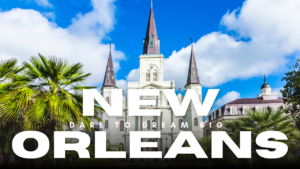Facts about New Orleans
Facts about New Orleans: One of the most well-known cities in the world is the Crescent City, sometimes known as New Orleans. Renowned for jazz, the French Quarter, and Bourbon Street. In 2018, New Orleans, one of America’s oldest cities, celebrated its 300th birthday.
This city has been a haven for the strange and unknown for more than three centuries. Although the first known Mardi Gras took place in 1699 just outside of present-day New Orleans, this city has witnessed numerous firsts and lasts. The events that have transpired within its municipal borders could be written about endlessly. However, we have discovered the ten most little-known facts about New Orleans after searching through the history books.

Facts about New Orleans10: The World’s Longest Continuous Bridge
The Lake Pontchartrain Causeway is the world’s longest continuous bridge, measuring 23.86 miles (38.4 kilometers), according to Guinness World Records. The south entrance to the bridge is located in Metairie, a municipality across from New Orleans; therefore, technically, it’s not in New Orleans. The wider New Orleans area, however, includes both the north and south entrances.

The causeway was constructed in 1956, and it has been so long that drivers have been known to get scared at night when they can no longer see the land on either side. Pregnant ladies have given birth on this bridge on multiple occasions while traveling to a hospital; they were unable to cross in time. Many visitors to New Orleans must use the causeway, which provides a view of the city skyline, a magnificent sight for both returning and arriving tourists.
Facts about New Orleans 9. The United States’ Longest Continuously Used Cathedral.
Mass has been celebrated every Sunday since 1794 in this white, triple-steepled cathedral on the north side of the French Quarter. Every day, thousands of people visit St. Louis Cathedral in Jackson Square, which is located across from the well-kept park and the bronze monument of Andrew Jackson. Christian places of worship often fall into one of four categories: cathedral, basilica, church, or chapel. A bishop is in charge of the cathedral, which is a far bigger house of worship than a church.
The oldest cathedral in the United States is St. Louis, whereas the oldest church is San Miguel Chapel in Santa Fe, New Mexico, which was constructed in 1610. This is where Marie Laveau spent her entire childhood going to Sunday mass. [
Facts about New Orleans 8: New Orleans Is Where Poker and Craps Were Created
Poque, the French forerunner of poker, was invented in the 17th century. The game was introduced to Crescent City by French colonists in the 18th century. English-speaking colonists changed the name to poker and modified the rules to create the modern version of the game. The word “crapaud,” which means frog in French, is where the word “craps” originated.
During his school years in France, Bernard de Marigny, a wealthy plantation owner from New Orleans, played a dice game called Hazards. He brought the game back to New Orleans, where he would stoop strangely when tossing his dice. He would stand like a frog, so his pals started calling him Crapaud. In recognition of this amusing story, the game was eventually changed and nicknamed craps.
Facts about New Orleans7: Bourbon Street Doesn’t Have a Whiskey Name
This misconception’s irony is exquisite, in fact. It was not named for the delicious beverage, even though Bourbon Street in the heart of the French Quarter consumes tons of bourbon every year. Pronounced with a focus on the second syllable, it was named after the European Bourbon Family. The street was established in 1718, the first year that the neighborhood that was once known as Bulbancha existed in New Orleans.
When French engineer Adrien de Pauger planned the city’s streets in 1721, he selected Rue Bourbon to bear the name of the French royal family that was in power at the time. With the exception of the French Revolution and the Napoleonic Empire, the House of Bourbon controlled France as absolute kings from 1589 to 1792 and again from 1814 to 1848. The dynasty’s members were derived from Louis I, Duc de Bourbon, grandson of King Louis IX, and it began as a branch of the Capetian dynasty, the Royal House of France.[4]
Facts about New Orleans 6: The Battle of New Orleans was won by the 6A Pirates.

The New Orleans underground and black market were controlled by the pirates Jean and Pierre Lafitte during the first ten years of the 1800s. Jean Lafitte ruled his own empire, which included an island and a private pirate force. They operated the island of Barataria, which is located roughly 25 miles (40 kilometers) south of New Orleans, while they were based there.
General Andrew Jackson was based in New Orleans when the War of 1812 began. Lafitte’s army was needed by both the British and the Americans. The Americans stormed Barataria with that in mind, seized the ships, and detained the men, including Lafitte. Jackson and Lafitte eventually reached an agreement after Lafitte broke out of prison. For pardons and Letters of Writ, Lafitte and his troops would fight for the Americans. With about 5% of the British casualties, the Americans prevailed. Since then, Lafitte has been regarded as a local hero.[5]
Facts about New Orleans 5: The only US mint in the country to produce two different kinds of currency
From 1838 to 1861 and 1879 to 1909, the New Orleans Mint functioned as a branch mint of the US Mint. For many months in 1861, this mint produced Confederate currency in addition to US currency. No other US mint has ever created two different kinds of currency.
Since 1910, the building—which was decommissioned as a mint—has been used as a fallout shelter, an assay office, and a storage facility for the US Coast Guard. In 1981, it joined the Louisiana State Museum as a division. It functions as two museums in one today. The Jazz Museum in New Orleans occupies one half, while the other half is devoted to the US Mints.
Facts about New Orleans No4: The First Pharmacy in America
The country’s first pharmacy was located in the French Quarter on Chartres Street. In 1816, New Orleans’ Dr. Louis Joseph Dufilho, Jr. obtained the nation’s first pharmacy license. He established America’s first licensed pharmacy in 1823. As a rapidly expanding city fought diseases like yellow and scarlet fever, he helped make science and medicine accessible. After 32 years of operating his well-known drugstore, Dufilho retired. A young doctor named James Dupas later purchased the drugstore from him.
Dupas succeeded him until his death in 1867 from syphilis-related problems. Dupas was revealed to be a serial killer who used chloroform to abduct women from the streets. By eliminating his “patients” in the middle of the night, it appears that he was attempting to perfect an abortion technique through trial and error. In addition to being a museum devoted to the history of pharmacies in America, the pharmacy is said to be haunted.[7]
Facts about New Orleans3: Spanish architecture makes up the majority of the French Quarter.
The French landed in what was then known as Bulbancha in 1717 under the leadership of Jean Baptiste Le Moyne de Bienville. They built the French Quarter using their own architecture. However, Louisiana was given to Spain by France in 1763. The French city’s appearance was altered by those and other incidents.
In the latter part of the 18th century, New Orleans experienced two significant fires: one in 1788 and another in 1794. Now that the city was under Spanish rule, the Spanish rebuilt using their own architectural style. Because early 18th-century French architecture used materials like straw and hay for insulation, which is why all but two of the old French Quarter’s buildings were destroyed, Spanish design was advantageous.[8]
Facts about New Orleans2: The American Mafia’s birthplace
The Big Easy was the birthplace of organized crime, despite the widespread belief that the American mafia originated in New York City. Originating from the Sicilian Mafia, it was officially known as the American La Cosa Nostra and initially showed up on New Orleans streets in the 1860s. New York did not see it until the 1920s.
Actually, the earliest Italian immigrants to the United States arrived in New Orleans. Before Baltimore and New York became more popular destinations for immigration, it also had one of the greatest Italian populations in the nation (Link 9). [9]
Facts about New Orleans 1: Where Dental Floss was born
Modern dental floss was created in New Orleans despite researchers finding evidence that ancient people utilized a variety of tools, including pointed sticks, to clean their teeth. In 1815, dentist Dr. Levi Spear Parmly of New Orleans conducted the first experiment with floss made of wax. A waxen silk thread should be inserted “through the interstices of the teeth,” according to Parmly. This is the most important aspect of dental care.
Unfortunately, floss wasn’t made commercially available until almost 70 years later. The Codman and Shurtleff firm started making unwaxed silk floss in 1882. The first dental floss patent was granted to the Johnson & Johnson office in New Jersey in 1898. The floss was created from the same silk that physicians used for silk stitches.
Facts About New York City
Perhaps the most famous city in the world, New York is a center of trade and culture that is both beautiful and cruel, diverse in terms of ethnicity, and uniquely American. The United Nations headquarters, the skyscraper from which King Kong fell, and the State of Liberty, which pledges to provide refuge to the weary, the impoverished, and the huddled masses from all over the world, are all located here. However, there are still some tales about New York that the world is unaware of.
Facts About New York City10: The Brooklyn Parrots
With the exception of rats and pigeons, New York is not well recognized for its wildlife. Nonetheless, a remarkable variety of animals, such as frogs, raccoons, turtles, and several dozen bird species, call the city home. There is one species that stands out among the seagulls and crows: the Quaker parrot. The vivid green parrot, which is native to South America, has made Brooklyn its home borough. It’s unclear exactly where these birds came from; some say they escaped from the Brooklyn Botanical Gardens or were released by a pet shop that closed. The most plausible reason is that local JFK Airport somehow opened a sizable consignment of crated birds that were shipped from South America for the pet trade. While the birds can be seen in several locations across the city, their nesting on the power wires of Brooklyn College’s athletic field is arguably the most well-known location.
Facts About New York City 9: The Century’s Greatest Artistic Crime
When Frenchman Philippe Petit walked the 61-meter (200-foot) tightrope between the World Trade Center’s twin towers in 1974, more than 400 meters (1,300 feet) above the pavement, he committed what has since been dubbed the “artistic crime of the century.”
This was no accident; years of preparation went into the stunt. Petit fabricated identification cards, conducted aerial reconnaissance, and entered the buildings covertly to conduct research while posing as office personnel and construction workers. On the morning of August 7, Petit and his accomplices passed progressively bigger ropes over the abyss with a bow and arrow until they were able to string up the steel cable he would walk on for forty-five minutes, making eight trips back and forth between the buildings. When Petit raced, bounced, and perched on the wire, he curtsied to the police officers gathered on the rooftops, all while laughing merrily. It was an enthralling performance.
He eventually turned himself in due to the weather after being alerted that a chopper was pursuing him. The tragedy gave the recently constructed World Trade Center, which had been viewed as an eyesore, much-needed positive publicity. Petit’s charges were dropped in exchange for a high-wire walk over Turtle Pond in Central Park as a community service project for kids. Since then, he has written a number of books and given performances all over the world, including over a dozen in New York City.
Facts About New York City 8: Women Without Tops
Times Square in Manhattan used to be a virtual Sodom and Gomorrah with sexual video shops, strip clubs, and peep shows. Although there aren’t many of these establishments left, it’s quite acceptable for women to go topless in New York City, so you don’t have to hide in a den of wickedness to see skin. The New York Supreme Court changed penal law 245.01, which deals with public immorality, in a historic decision in 1992, permitting women to wear no shirt like males. Even though it’s a privilege that is rarely used, the city felt compelled to remind the police earlier this year that it is not illegal to have exposed breasts. An enormous number of half-naked women congregate in Central Park in August to commemorate International Go Topless Day, an occasion that consistently attracts large crowds.
Facts About New York City7: The Hellish Elevator Ride
The elevator gave rise to New York’s skyline; without it, structures more than a few stories would not be feasible. Additionally, elevators are incredibly safe, unlike what movies and television would have you believe. They are very flimsy devices, though, and getting stuck is not unusual. Usually, a small mechanical problem that can be resolved in a matter of minutes is the cause. However, in 1999, Nicholas White, a New Yorker, had the greatest nightmare of claustrophobia when the elevator he was using remained stuck for forty-one hours.
White was the production manager for Business Week and was employed in the McGraw-Hill Building in the Rockefeller Center in Manhattan. One Friday night, he decided to take a smoke break while working late. He took a cigarette, rode the elevator down, and was trying to get back to the forty-third level when his elevator broke down. White set off the alarm and tried to use the intercom. The elevator had a camera, and he anticipated being rescued soon by security guards. There was no assistance. He smoked his cigarettes and paced frantically. He eventually forced open the doors to reveal a wall made of cinder blocks. He ultimately had to use the elevator shaft to urinate.
Facts About New York City 6: The Hole
With so many people packed into tall buildings like bees in a hive, New York City is notorious for having an exceptionally high population density. Although the cost of real estate is quite high, the city does, surprise, have wastelands. One area is in Queens’ Ozone Park neighborhood, which is home to John “Teflon Don” Gotti, the boss of the Gambino crime organization. The subterranean area known as “The Hole” is not connected to the New York sewer system and is so prone to flooding that the few people who live there must use boats to get around. The fact that the Gambinos have been buried here is even more horrific. The FBI found the skeletal remains of mobsters while looking for the remains of John Favara, a neighbor who disappeared after unintentionally hitting John Gotti’s kid with his automobile.
Facts About New York City 5. Crime
During the 1970s, 1980s, and early 1990s, New York City had a terrible reputation for crime. After dark, only the brave, the insane, or the terribly addicted to drugs would go into places like Central Park. The subways were plagued with violence and covered with layers of graffiti. There were 2,154 homicides in 1992, during the height of the crack cocaine epidemic. There were 414 in 2012. There should be even fewer in 2013.
What then took place? Numerous possibilities exist, ranging from the decrease in crack use to better-computerized policing techniques. Other hypotheses are more contentious; some contend that the legalization of abortion is directly responsible for declining crime rates. A generation of children who may have experienced abuse and neglect were “culled” from society eighteen years later. Regulations prohibiting the use of lead in gasoline and paint, which can cause developmental impairments in children, are also thought to have played a role in the reduction.
For whatever reason, the city’s citizens are thankful that families and dogwalkers can again congregate in areas that were formerly controlled by gangs and drug traffickers.
Facts About New York City 4: Ota Benga
With almost 4,000 creatures from 650 different species, the Bronx Zoo is a global leader in its profession. The Congo Gorilla Forest, the Wild Asia Monorail, and Tiger Mountain are currently the most visited exhibits. However, it also included a contentious exhibit called “The Missing Link” in 1906. It featured a pygmy from the Congo named Ota Benga. Ota’s story was a depressing one; he was bought from African slave traders to be displayed in the US after his family was massacred.
Benga only stayed at the zoo for a brief period of time before the administration gave in to public uproar over the practice of displaying a human person like an animal. He worked at a tobacco plant after spending some years in an orphanage and being somewhat integrated into American culture. Ota Benga constructed a ceremonial fire and then shot himself in the heart when the First World War interrupted his intended return to the Congo. His age was thirty-two.
Facts About New York City 3: Walmart
Walmart surpassed even the massive oil and gas giants, such as Exxon Mobil and Saudi Aramco, to become the largest corporation in the world by revenue as of 2013. Walmart has a presence in all 50 states and around the world, with about 9,000 sites. However, none of the five boroughs of New York will have one of these superstores. These stores would provide an unmatched price point, which would be especially advantageous for low-income New Yorkers due to their amazing wholesale purchasing power.
Nevertheless, Walmart, which is well-known for forbidding its workers from organizing unions, has failed to reach a financial agreement with the city of New York due to the city’s high level of unionization. There have been unsuccessful attempts to open stores in Brooklyn, Staten Island, and Queens. Harold Lee Scott Jr., the former CEO of Walmart, is known to have said, “I don’t care if we are ever here.” It’s not worth the effort.
Facts About New York City 2. Diversity in Linguistics
With more than 30% of its citizens being foreign-born, especially in the Queens borough, New York is a veritable melting pot of the world. With more than 800 different languages spoken by its residents, the city is thought to have the most linguistic diversity on Earth. Many, like Garifuna, a dialect combination of African, West Indian, and indigenous South American languages, are extremely uncommon. The City University of New York has started an initiative called the Endangered Language Alliance to preserve uncommon languages, including Bukhari, Vhlaski, and Ormuri because some of these languages are in danger of going extinct.
Facts About New York City 1: The Only Homicide of 19/11
New York saw unspeakable violence on September 11, 2001. Shell-shocked citizens huddled around their televisions, slowing down the city’s normal activity. However, the skyscraper collapse in Manhattan would tragically obscure the catastrophe that would take place in Brooklyn that night. Henryk Siwiak, a Polish immigrant, left his flat that evening to start a new job cleaning floors at a Pathmark grocery. In order to provide for his wife and two kids, he had to relocate to the United States after losing his work in his own country.
Henryk asked his landlady to assist him in locating the business where he would be working because he was unfamiliar with the city. Regretfully, she sent him to the incorrect location in Bedford Stuyvesant, a violent neighborhood. Several people claimed to have heard shots, but none of the eyewitnesses came forward. Siwiak walked up a stoop and rang a doorbell for assistance, as shown by a trail of blood. No one answered the door after hearing the gunfire. He died after tripping down the steps and landing on the sidewalk. He had more than $70 in unopened cash on him when his body was discovered. The reason for his death is still unknown because he lived in a strange neighborhood where no one would hold a grudge against him.
Siwiak’s murder scene was only briefly examined because almost all of the city’s police officers had been called to Manhattan. An evidence collection team, which responds to nonfatal crimes like burglaries, was deployed in place of the forensic Crime Scene Unit often assigned to killings. The authorities are still no closer to apprehending Henryk Siwiak’s killer over ten years later.

